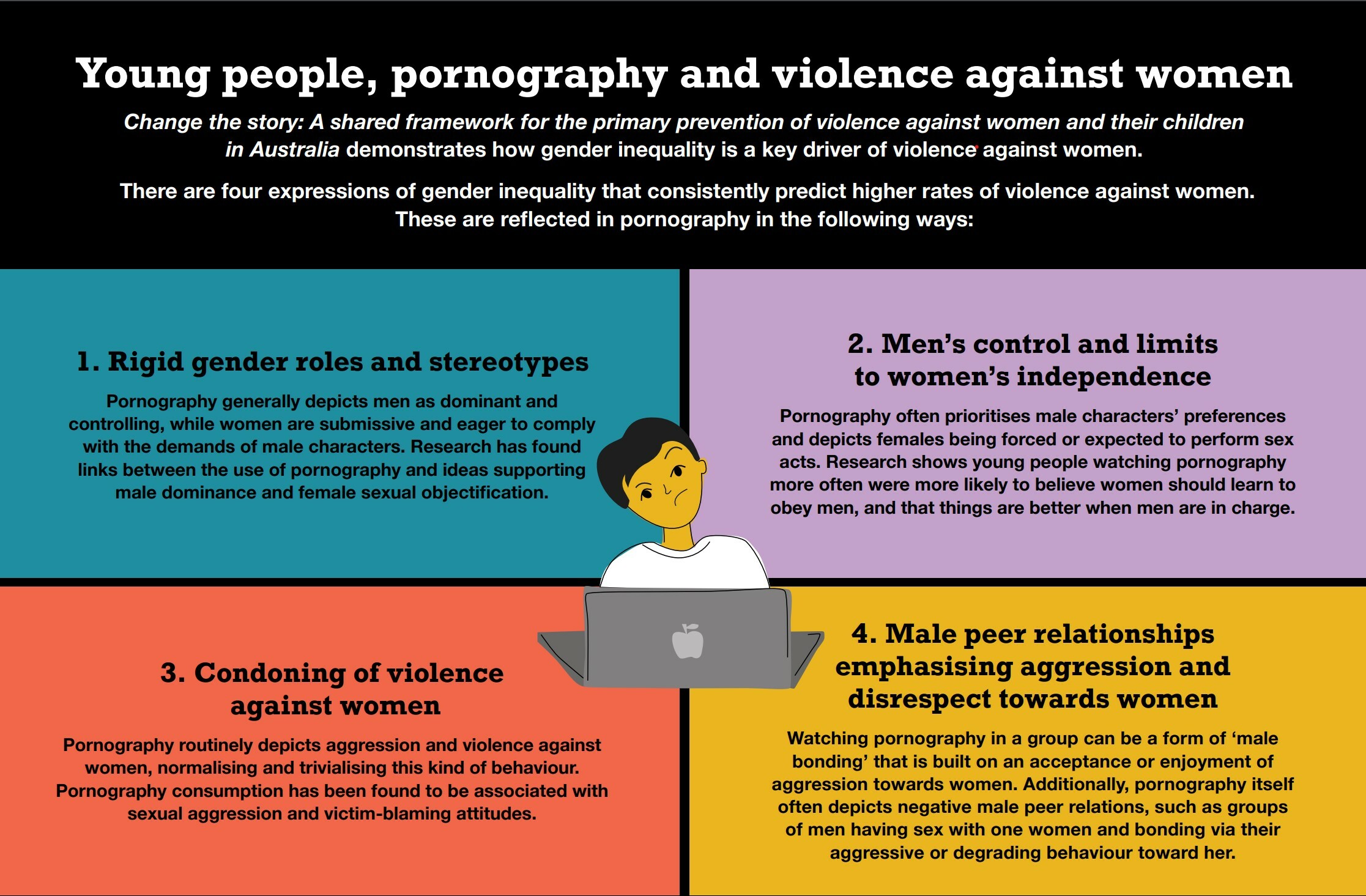Pornography is of concern to those working to prevent violence against women, and promote respectful relationships and gender equality, because of the ways it reinforces the attitudes and beliefs that are known to drive violence against women.
Change the story: A shared framework for the primary prevention of violence against women and their children in Australia demonstrates how gender inequality sets the context in which violence against women occurs. There are four expressions of gender inequality—known as the ‘drivers’ of violence against women—that consistently predict higher rates of violence against women.
Our Watch’s background paper, Pornography, young people and preventing violence against women, discusses how pornography reflects and reinforces each of these drivers. The background paper brings together findings from the literature, as well as Our Watch’s research with almost 2,000 young people, aged 15-20, from around Australia. Some of the findings are discussed, below.
Driver 1: Rigid gender roles and stereotyped constructions of masculinity and femininity
Pornography commonly depicts stereotypical representations of men and women. Men are often portrayed as aggressive, dominant and controlling¹ and women are often portrayed as submissive, eager and willing to comply with the wants and demands of men.² Pornography also commonly depicts limiting stereotypes based on other factors, such as race and age. For example, Asian women are typically depicted as submissive.³
Women are routinely objectified in pornography—for example, close-ups of women’s body parts are much more common in pornography than close-ups of men’s body parts.⁴ At the same time, men’s pleasure is valued over women’s pleasure in pornography, with men significantly more likely to be depicted experiencing orgasm.⁵ In pornography, women are not portrayed as important or valuable in their own right—any pleasure women derive is secondary or irrelevant.
Pornography suggests that women deserve to be treated as subservient, and as objects for male sexual gratification—this can cast women as targets for exploitation.⁶ Research has found links between the use of pornography and support for rigid gender roles—including male dominance⁷ and female sexual objectification.⁸
Driver 2: Men’s control of decision-making and limits to women’s independence in public and private life
Pornography routinely prioritises the preferences of male characters and depicts men dominating women. This sends a message that women have a lower social value and are less worthy of respect—messages that can contribute to the belief that women are legitimate targets for violence.⁹
Our Watch’s research shows young people who watched pornography on a more regular basis were more likely to believe that women should learn to obey men, and that things tend to be better when men are in charge.¹⁰
Driver 3: Condoning of violence against women
The bulk of evidence identifies frequent depictions of violence in pornography.¹¹ Significantly, both the physical aggression in pornography (such as hitting, slapping, choking and gagging) and the verbal aggression (such as name-calling) are almost always directed towards women. Female characters are often depicted as enjoying being subject to aggression—which can make the violence in pornography difficult for viewers to recognise. Pornography’s portrayals normalise violence against women—but even more troubling, they suggest that violence against women is sexy.
Pornography consumption has been found to be associated with both verbal and physical sexual aggression.¹² Research has found that men who are very frequent pornography users have sexual aggression levels that are much higher than their counterparts who do not consume pornography very frequently.¹³
Driver 4: Male peer relations that emphasise aggression and disrespect towards women
Pornography can reinforce aggressive and disrespectful male peer relations in two key ways. Watching pornography—including aggressive and degrading pornography—in a group can be a form of bonding between young men.¹⁴ Pornography also depicts disrespectful and aggressive male peer relations, for example, in scenes where groups of men are having sex with one woman and treat her aggressively, or as an object for their shared pleasure.
Our Watch research indicates that young men who more frequently consumed pornography were more likely to believe there is no harm in men making jokes about women in front of their friends.¹⁵

Download the Young people, pornography and violence against women infographic here.
The ways that pornography reflects, reinforces and eroticises the drivers of violence against women, combined with young people’s high levels of exposure and access to pornography at a critical time in their development, makes pornography an important issue to address with young people.
Practitioners can help support young people to successfully navigate pornography’s influence, and develop relationships and sexuality that are safe, respectful, mutual and consenting by incorporating a focus on pornography into their work.
References
¹ Gorman, Monk-Turner and Fish. (2010). Free adult internet web sites: How prevalent are degrading acts? Gender Issues, 27, 131-145 and Marleen J.E Klaassen and Jochen Peter. (2015). Gender (In)equality in Internet Pornography: A Content Analysis of Popular Pornographic Internet Videos. Journal of Sex Research, 52(7), 721-735.
² Gorman, Monk-Turner and Fish (2010), see note 1.
³ Yanyan Zhou and Bryant Paul. (2016). Lotus Blossom or Dragon Lady: A content analysis of “Asian women” online pornography. Sexuality and Culture, 20, 1083-1100.
⁴ Klaassen and Peter (2015), see note 1.
⁵ Ibid.
⁶ Our Watch, Australia’s National Research Organisation for Women’s Safety (ANROWS) and VicHealth. (2015).Change the story: A shared framework for the primary prevention of violence against women and their children in Australia.
⁷ D Brown and K.L L’Engle. (2009). X-rated: Sexual attitudes and behaviors associated with US early adolescents’ exposure to sexually explicit media. Communication Research, 36, 129-151 and E Haggstrom-Nordin, J Sandberg, U Hanson and T Tyden. (2006). ‘It’s everywhere!’ Young Swedish people’s thoughts and reflections about pornography. Scandinavian Journal of Caring Science, 20, 386-3936.
⁸ J Peter and P.M Valkenburg. (2009). Adolescents’ exposure to sexually explicit internet material and notions of women as sex objects: Assessing causality and underlying processes. Journal of Communication, 59, 407-433 and J Peter and P.M Valkenburg. (2007). Adolescents’ exposure to a sexualized media environment and their notions of women as sex objects. Sex Roles, 56, 381-395.
⁹ Our Watch (2015), see note 6.
¹⁰ Our Watch (2020). Background paper: Pornography, young people and preventing violence against women.
¹¹ Ana Bridges, Robert Wosnitzer, Erica Scharrer, Chyng Sun and Rachael Liberman. (2010). Aggression and Sexual Behavior in Best-Selling Pornography Videos: A Content Analysis Update. Violence Against Women, 16 (10), 1065-1085.; Klaassen and Peter (2015), see note 1; Eran Shor and Kimberly Seida. (2019). “Harder and Harder”? Is Mainstream Pornography Becoming Increasingly Violent and Do Viewers Prefer Violent Content? The Journal of Sex Research, 56, 16-28; and Office of Film and Literature Classification. (2019). Breaking Down Porn: A Classification Office Analysis of Commonly Viewed Pornography in NZ.
¹² PJ Wright, Robert S Tokunaga and Ashley Kraus. (2016). A Meta-Analysis of Pornography Consumption and Actual Acts of Sexual Aggression in General Population Studies. Journal of Communication, 66, 183-205; V Vega, & N Malamuth. (2007). Predicting sexual aggression: The role of pornography in the context of general and specific risk factors. Aggressive Behavior, 33(2), 104-117.
¹³ Neil M Malamuth, Tamara Addison and Mary Koss. (2000). Pornography and Sexual Aggression: Are There Reliable Effects and Can We Understand Them? Annual Review of Sex Research, 11, 26-91.
¹⁴ C Bryant. (2009). Adolescence, pornography and harm. Trends & Issues in Crime and Criminal Justice, 368, 1-6.
¹⁵ Our Watch (2020), see note 10.





